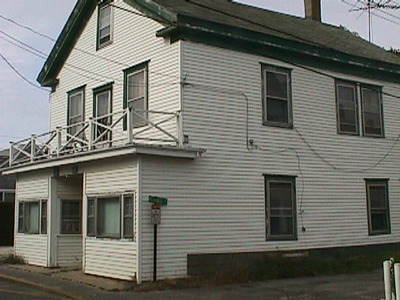90 Commercial St
Historic District Survey information for 90 Commercial St | |
Architectural Description: 90 Commercial St. is a 2-story, 3-bay former mixed-use commercial/residential building; gable-front roof is sheathed in asphalt shingles and has partial cornice returns; interior stucco-clad chimney at rear roof ridge; small exterior concrete block chimney on west facade; exterior is clad in clapboard and aluminum siding; fenestration includes Chicago-style picture windows with 4/4 DHS on 1st-story storefront, 6/6 DHS adjacent to entry, 2/2 DHS with storms, 2/1 DHS with storms on east facade, 2/2 wood DHS with storm windows on west facade, 2/2 DHS with wood trim on rear facade; main entry is recessed in center bay of projecting 1st-story storefront; 2nd-story deck entry on front facade accessed by replacement door and storm door; secondary entry located on east facade; projecting storefront has 2nd-story open deck with crossed diagonal-board balustrade; rear facade has open porch with 2nd-story wood deck, and one entry on 1st story and two on 2nd story; west facade has wood trim/cornice. |
|
Historical Narrative: As per Josephine Del Deo (1976): "This building housed Provincetown's first and oldest bank. The date is listed by the bank archives as 1851. Previously to the location of offices in the building, the bank offices were temporarily located in the Union Wharf property opposite at 99 commercial St. (now Sal's place restaurant and wharf). The bank remained here for a number of years until it relocated at 274 Commercial St in 1892. It now occupies a third location on Commercial Street (see #55-P). the building is largely unaltered exteriorly from its original construction.
As per Tom Boland (1994): The Union Wharf was built in 1831 and a marine railway was added in 1852. In its heyday the wharf was one of several over 1000 feet long. In 1858, the Union Wharf Store was located at #99. In 1858, it is noted as the J. Nickerson Store and by the late 1880s through 1901, a ship chandlery was operated here and run by Andrew T. Williams, who called it the West End Market. It dealt in ships' stores, coal, wood, flour, groceries, seamen's outfits, paints and oils. Charles and Artemus Hannum, noted local sail makers, and J.H. Livermore, a blacksmith, also operated out of here.
The first branch of Seamen's Savings Bank was operated in #90 the Union Wharf store from 1851 to 1860, as was the Atlantic Mutual Insurance Company at about the same time. It continued in active use until 1902 when it is listed as vacant and owned by J. Gracus. In 1901, #101 was owned by B.R. Kelley. A.R. Bent, fisherman, is noted as having worked out of here. In the early 20th century the area was broken into separate parcels with #99 becoming a restaurant and rental units, #101 and #90 becoming residences. |
|
Bibliography and/or References: Barnstable County Atlas., 1880.
Barnstable County Atlas., 1907.
Cape Cod Directory, 1901.
The Extremity of Cape Cod. Map, 1836.
H.F. Wallings Co. Map of Provincetown Village. Atlas, 1858.
Jennings, Herman A. Chequocket or Provincetown. 1893.
Jennings, Herman A. Provincetown. or Odds and Ends from the Tip End. 1890.
Provincetown Advocate. November 11, 1984.
Resident Directory. W.F. Richardson & Co., 1886.
Resident Directory. W.H. Hopkins, 1889.
Ruckstuhl, Irma. Old Provincetown in Early Photographs. Toronto, 1987.
Sanborn Fire Insurance Company. Map, 1889.
Sanborn Fire Insurance Company. Map, 1902.
Vorse, Mary Heaton. Time and the Town. Provincetown, 1942. |
|
Text |
|
Commercial Street (Provincetown, Mass.), Dwellings, and Historic Districts--Massachusetts--Provincetown |
|
Comments (0)
NOTICE: It appears you do not have Javascript enabled in your Web browser. To access some of the features on the site (including email links) you must enable Javascript and refresh the page.



There are no comments for this archive.